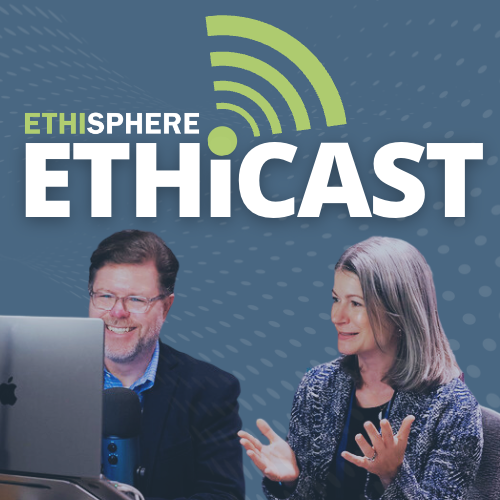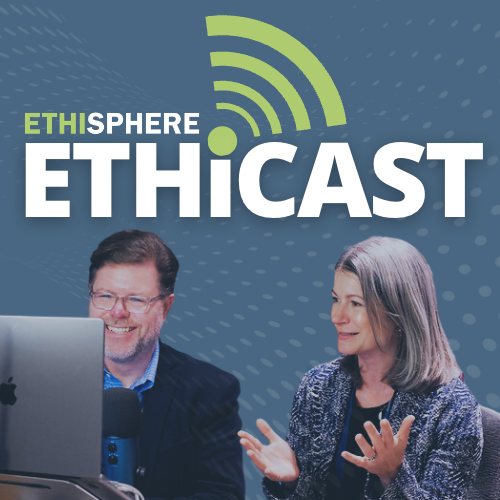[00:00:01] Speaker A: Hi everyone. The Business Ethics Leadership alliance has questions and we have answers. I'm your host, Bill Coffin. Welcome to another Bella Asks episode of the Ethicast.
The Business Ethics Leadership alliance, or bela, is a global ethics and compliance community that that provides exclusive access to helpful data, program benchmarking, roundtable events, and a resource library with hundreds of policy guidance documents, member contributed program examples, and more. One of Bella's most popular benefits is the concierge service in which members can submit any question at all regarding ethics and compliance, and our internal experts will provide an answer and helpful resources with additional information.
And while we invite everyone watching and listening to join bela, we also know that there's no competition in compliance, which is why we're using this program to thematically respond to high level questions from the Bella community for the benefit of ENC teams everywhere.
And joining us once again to answer those questions is Bella chair Erica Salmon Byrne. Erica, it's great to see you again.
[00:01:11] Speaker B: Oh, Bill, thank you so much for having me back. I'm excited to answer today's question.
[00:01:15] Speaker A: Well, today's question is a program oriented question and it reads, what should a code of conduct look like in 2025?
[00:01:23] Speaker B: Yeah, I love this question because it tells me that the company that is asking this question is taking a big step back and thinking about the ro, the role rather that the code plays in the written standards ecosystem that the organization has established. I have long likened that ecosystem to a layer cake where the code of conduct is the bottom layer of the cake and then the cake gets narrower as you go up. And the reason I say the code of conduct is the bottom layer of the cake is that is the one document that should be written, designed and rolled out with the assumption that every employee across the organization, regardless of role, location or language, is going to access. So in other words, you design it at the lowest reading level, with the broadest amount of accessible language and with enough information on your key risk topics that your employees, no matter where they are, know enough to either go get more information if they need it or spot a red flag if they have to. So if you start from that kind of assumption and you've got the code, you're thinking about the code. That way you then add on the other layers of your cake in the form of policies, procedures, FAQs, manager, guidance, all of those kinds of things. And each one of those things, those circles, has a slightly smaller audience. So not every employee, for example, is going to need to know the ins and outs of your import export policy, but they're going to need to know enough of import export risk if you are importing and exporting things to be able to spot red flags and then go to the policy if they need more information. So in terms of what your policy, what your code should look like in 2025, you should be cross referencing all the policies that you have in place that are applicable to the risk topics you've included in the code. The code itself should cover your all of all of the risks that are applicable to every employee with guidance on where to find more information if they need it. And you should be thinking carefully about modality. How do you think most employees are going to access this document? Are they going to access it through a chatbot? Are they going to access it on the web? Are they going to access it in a mobile app? Are they going to access it on a PDF on their phone? Right. How are you actually going to get this information in the hands of employees? And that question should guide your design and development of the code.
[00:03:58] Speaker A: Well, Erica, I have a follow up question. Is that all right?
[00:04:00] Speaker B: Absolutely, Bill.
[00:04:02] Speaker A: So the thing I took away from this question is what should a code of conduct look like in 2025? And initially I kind of figured, well, this is coming from a place of annual review and renew annual, you know, re examination of the code. But then I stopped and I looked at it from the other way of maybe asking is there something specific about 2025 that people should be taking into account as they, as they create or refresh the code of conduct. So to that end, is there anything that's particular to the ENC environment right now, this year that might require inclusion or you would recommend inclusion into codes of conduct that maybe weren't typically included before?
[00:04:36] Speaker B: That's a really interesting way of asking the question, Bill. The way I read the question was I haven't updated my code in a couple of years. What does a modern code look like? Right. So sort of that was the way that I went in my head with the question and that is of course the way that I answered the question.
I don't think there's anything particular about 2025 specifically as it pertains to the code. That is going to be a different way of thinking about topics compared to 2024 or 2026. And I say that because your code of conduct should be tied into your risk assessment.
The risks that you as a business are facing, your inherent risks because of the markets you're in, the products you sell, the people who buy your goods, the suppliers that you engage with Those things are those things, right? You are in, you are in the risks, the business you are in is causing the risks that you face. And those risks should be reflected in your code.
It's a little different than maybe a decade ago when we first started seeing companies really put social media language in their code of conduct, for example, that was a universal risk risk topic that most companies were not covering in their code. And we saw that kind of evolution over the course of the last decade where companies started putting language in to say, like, hey, you know, if you're, if you're engaging in social media, make sure that you make it clear that everything you're expressing is your own opinion and not the opinion of the company. And sort of here's how to handle some of those risks. So there isn't really something out there right now that I would say is that kind of universally applicable. Now if you are an organization that is engaging with a lot of suppliers that are using itinerant labor, right. Your, your child labor, forced labor, human slavery risk is higher than it was before because of some of the exposure that has been put on that issue. And as a result, some of the regulatory environment changes that we have seen over the last couple of years. So I do think there are things like that that would be industry specific changes that you probably want to take a look at, but that would all go back to your risk assessment. Right. One of the things, Bill, that I have long used as a test for a code of conduct is I have covered up all the company names in the code and I've asked myself, if I'm just reading the text without the name of the company, could I tell what industry this company is in, Could I tell where they might be doing business?
And bonus points, could I actually tell who the company is based on the way they talk about the work they do?
That is the standard you should be holding yourself to when you think of your code of conduct. Because if you do that, that means that you've written a code for your company, for your industry, for your risks, and it's not going to look like everybody else's. And that is how you actually build a document that your employees are going to engage with. And at the end of the day, that's the point of the code.
[00:07:41] Speaker A: Well, Erica, this has been a terrific conversation. I love the layer cake analogy and it's super helpful for getting your hands around this topic. So thank you so much for coming on the program today.
[00:07:49] Speaker B: Absolutely, Bill, my pleasure. I hope everybody else liked the layer cake analogy. It's lunchtime here while Bill and I are recording. So I'm a little peckish. So, you know, there you have it. But thanks so much for having me back, Bill. It means that our members have more questions. And to all of you out there listening that have those questions, please keep them coming so that I can come back.
[00:08:08] Speaker A: To learn more about Bella, please visit ethisphere.combella to request guest access to the Member Resource Hub and to speak with the Bella Engagement Director. And if you have a question that you would like answered on this program, contact the Bella Concierge Service and we'll get to work on it for you. I'm Bill Coffin, and this has been another Bella Asks episode of the Ethicast. If this is your first time listening, we hope you've enjoyed the show. For more content like this every week, please subscribe here on YouTube, Apple Podcasts, or Spotify. You can also get our free weekly
[email protected] ethicast and we've got plenty more content for
[email protected] resources. Thanks for joining us. And until next time, remember, strong ethics is good business.


